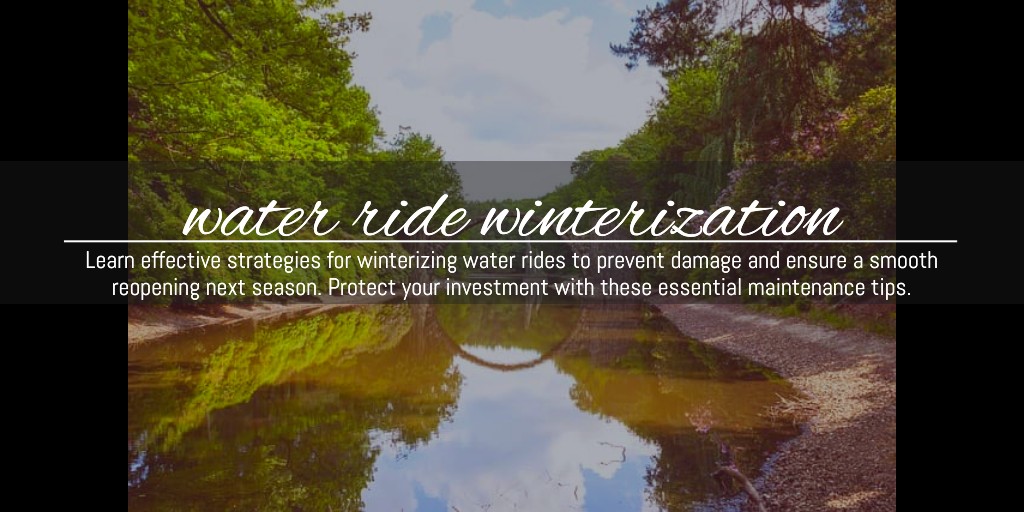Winterizing Water Rides: Essential Tips for Off-Season Care
By Elan Groberman, Performance Services Manager
As the crowds disperse and children return to school, thoughts turn to winter shutdown. Whether you’re preparing for a brief off-season or gearing up for months of freezing temperatures, the following tips will assist you in the water ride winterization process for your attractions—be it log flumes, Super Flumes, river rafts, or Shoot the Chutes—ensuring a fantastic start to the next season.
Not Just Fear-Mongering: What Can Happen If You Don’t Winterize Properly
Amusement and theme parks often close for extended periods due to the harshness of cold weather and precipitation. Freezing temperatures, moisture, prolonged UV exposure, and inactivity can lead to costly and unpleasant surprises come spring.
- Water expands by 10% when it freezes, creating significant force that can cause damage.
- Heavy rainfall can lead to water pooling, resulting in damage from excess moisture and weight on equipment.
- Extended exposure to UV rays can degrade materials such as plastics, rubber, and foam.
- Prolonged inactivity increases the risk of rides seizing, losing lubrication, or developing flat spots.
And we haven’t even touched on the issue of corrosion!
The good news is that all these problems can be avoided with the right precautions. Drawing from decades of experience supporting water rides globally, our team is eager to share some best practices to help you get started.
Run, Test, Record: Establish a Known Condition Before Storage
Before you put your ride into hibernation, it’s crucial to establish a baseline. Begin by creating an end-of-season checklist, then:
- Test every function and all sensors.
- Record currents, voltages, speeds, fluid levels, and user settings.
- Thoroughly clean your ride and remove debris (such as leaves that can create their own ecosystem, leading to mould, corrosion, and staining).
- Visually inspect your ride and document any repairs needed for spring.
- Take photos from various angles, both close-up for details and wider shots for context.
- Release tension and stored energy from hydraulic systems, pneumatic systems, springs, belts, counterweights, capacitor banks, and any other systems that could pose a risk with a sudden release of energy.
Warm, Cozy, and Protected: How to Store Your Ride
If possible, move your ride vehicles into covered storage and lift the wheels off the ground to prevent flat spots. Additionally, store any non-metallic components from your ride in covered storage, including large items like conveyor belts. However, be cautious about placing equipment in steel containers, as they can become excessively hot in the sun, potentially melting plastics and soft goods.
If moving your vehicles into storage isn’t an option, cover them with tarps or industrial shrink wrap, similar to what you see on boats during winter. Ensure these coverings are secure to prevent flapping in the wind or pooling water.
Not Just for Moving: Lubrication
Grease plays a vital role even when the equipment is stationary. Before you put your ride to bed:
- Ensure all lubrication points are adequately lubricated.
- Apply wax or a corrosion inhibitor to protect exposed steel, such as chains and shafts; pay special attention to items that are usually submerged and are seeing air for the first time this year.
- If possible, remove chains to store them in oil.
- Ensure that any protective measures can be safely removed later.
- Retract cylinders to safeguard the piston rods.
These Things Need to Be Nice and Dry
Avoid the risk of water freezing in your ride. Be sure to drain, blow out, and/or vent:
- Water pipes (and pneumatic lines containing moisture)
- Water pump housings
- Flanges with pooling water
- Oil-filled volumes with moisture
- Even items like eye wash stations
Your Ride Is Not an Animal Shelter
Who doesn’t appreciate a warm and dry place to stay during winter? Raccoons, rodents, and other furry creatures certainly do. They may take up residence in your ride or storage area, bringing food, chewing, clawing, and even using it as a toilet. In some cases, these critters can get trapped and not find their way out.
Therefore, seal off areas where possible.
Power On or Off?
When you prepare these giants for winter, consider leaving a nightlight on. Some components require trickle power or the warmth of a light bulb. Certain PLCs need power to retain memory, so be sure to record any seasonal statistics or settings before shutting down. Also, check if any circuits need to remain powered to maintain battery life. Some batteries can die if left unused for too long, including those in emergency light signs. Certain batteries self-discharge without a load, and some circuits draw a constant trickle. If these batteries drop below about 50% capacity, they may lose their ability to recover properly.
Your Spring Self Will Thank You
Before your ride enters hibernation, ensure you have everything ready for its “wake-up” in spring.
- Complete a spare parts inventory.
- List required maintenance tasks and service parts.
- Identify any upgrades or replacements for the following year.
- Order parts and services now rather than waiting until the week before spring.
Throughout the winter break, check on your ride every 4 to 6 weeks, depending on your environment. Rotate any parts that should be moved during the season and inspect for any changes in condition.
Preparing for a New Season: Waking Up Your Ride
As spring arrives, you’ll be getting ready to “wake up” your ride and its systems. This involves removing debris, pressure washing, and evicting any critters. Locate the O&M manual for your ride and adhere to all instructions provided.
Generally speaking:
- Refer to the records and photos taken in autumn and compare them to the current condition.
- Re-lubricate parts, even if the ride has remained stationary all winter.
- Slowly refill drained systems to prevent damage and ensure proper pressurisation; watch for air locks in any high spots of the piping system.
- Gradually activate motorised systems to get them moving again.
- Follow a structured pre-season commissioning process and checklist to confirm readiness.
- Conduct cycle testing, both loaded and unloaded, to ensure proper operation under various conditions.
Before allowing patrons onto the ride, test the equipment according to the procedures outlined in your O&M manual.
After all your diligent preparation—and with hopes for plenty of sunshine—you’ll be set for a brilliant start to the new season.






